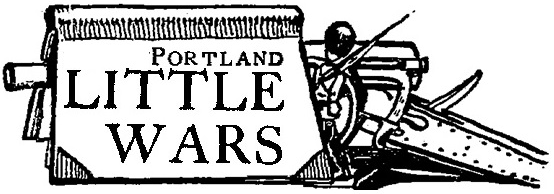(1) All the Kings Men (Sudan variant)
(2) Hail Caesar (Punic Wars)
(3) Lion Rampant Battle of Clontarf (9th century Ireland)
(4) Pike & Shotte (English Civil War - Scots vs. Royalists)
(5-6) The Men Who Would Be Kings (2 games, Crimean War)
(7) Song of Arthur & Merlin (Arthurian skirmish)
(8-9) SAGA and Pikeman's Lament (Portland Historical Wargames games day @ Guardian)
(10-13) Enfilade (4 games: Hail Caesar, Pike & Shotte, Canvas Eagles, & an ancients game)
(14-15) All the Kings Men (2 games, Seven Years War)
(16-17) Saga (2 games, Portland Historical Wargames games day @ Guardian)
(18) Pikeman's Lament ('big battle' variant, Scots vs. Royalists)
(19) Black Powder (Napoleonic)
(20) Pikeman's Lament Battle of Middelwich ('big battle' variant, ECW)
(21-22) Saga (2 games, Portland Historical Wargames games day @ Guardian)
(23-26) Saga (3 games, tournament) and Hail Caesar (Romans vs. Britons)
(27) Pikeman's Lament Relief of Montgomery Castle ('big battle' variant, ECW)
(28-29) Black Powder, 'Almost the Alma' playtests (2 games, Crimean War)
(30) Guns of Liberty (AWI game at Ambuscade!)
(hosted only) Black Powder 'Almost the Alma' (hosted Crimean war game at Ambuscade!)
I played 30 games in 2017 + 1 where I only participated as the game's host.
Painting-wise 2017 was a toss-up. I painted the majority of my Crimean War 20mm collection starting last winter, so that was a big accomplishment. The other big to-do was a bunch of ECW cavalry, two more ECW pike units, and getting a good start on Italian Wars infantry. The ECW and Crimean work allowed me to run some good games. But I don't feel like I made a lot of progress on the unpainted backlog, and I have a few collections that feel incomplete and unused that I feel could be more active with a concentrated effort.
I sold my entire 54mm painted Sudan and 54mm Seven Years War collections for comparatively princely sums – so I now waste a lot of time contemplating new eras to collect, paint, and game with. My self-control is evidently much better because I have not gone through with any purchases yet, as I want to decimate the Italian Wars lead mountain first and foremost! One very likely target is a Battle of Mount Badon project, mainly because I have about half the minis already painted (they would need to be multi-based) so the additional buy-in is comparatively low. Other projects I have contemplated include 13th century medieval, 11th century Byzantines vs. Bulgarians, and 16th century Safavids vs. Ottomans.
The only certain goals for 2018 is the completion of two Italian Wars armies and to host a game with those armies at Enfilade in May, as well as to organize the third annual Ambuscade! gaming event here in Portland. Other things I would like to accomplish include some selective selling of other painted figures and unpainted figures, and making a big buy-in on the Next Project, whatever it may end up being.








































